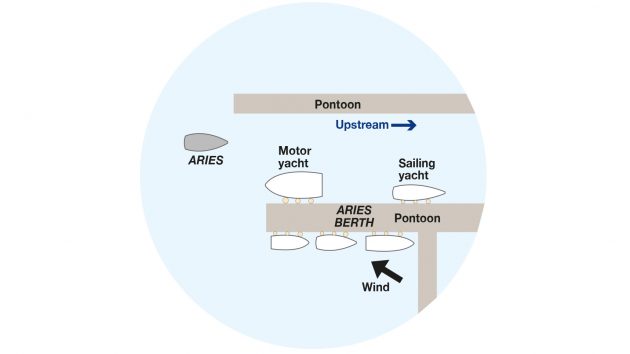James Stevens considers a problem sent in by a Yachting Monthly reader who wants to know how to moor their yacht in a tricky windward slot
Andy’s home berth is alongside a walkashore pontoon on a river. Outside is another pontoon not attached to the shore. There is quite a strong tidal stream, up to 2 knots at mid-tide.
Although the berth is convenient for getting ashore there are only two or three metres clearance at each end as it is sandwiched between a large and beamy motor yacht and another sailing yacht. Andy has a 10m standard production fin-keeled yacht, Aries, with a three-bladed prop and with a prop kick to port when engaged astern and no bow thruster.
He is arriving back from a day sail on his own. There is a fresh wind blowing diagonally off the pontoon and no one nearby to help. It is High Water and the tidal stream is slack.
Andy has prepared fenders on the starboard side as the wind will be on his starboard bow with the motor yacht astern. He has bow and stern warps and a warp attached to the yacht’s midships cleat which he plans to take ashore and attach to a handy pontoon cleat as soon as he is alongside. He can then secure the other warps.
The problem is that in the time taken from stopping the yacht at the helm position to reaching the midships warp and jumping on to the pontoon the bow blows away. Andy has no special equipment for taking a warp to a pontoon without stepping off the yacht. What would you do?

How to moor a yacht in a tricky windward slot
With such a tight berth either the bow line has to be attached to the pontoon quickly, clearly impossible for a single hander, or the midships line has to be attached to snub the yacht close to the pontoon. If the midship warp is too long the yacht will blow down to the motor yacht behind. This is a really difficult manoeuvre when single handed, especially with the prop kick taking the yacht away from the pontoon when astern is engaged.
It might be possible to approach astern into the wind to attempt to secure the stern warp first. The wind will blow the bow directly downwind so the first part of the yacht to make contact with the pontoon would be the port stern quarter, and it would only stay there for seconds.
Approaching from upwind would only be possible if there was no moored yacht in the way. Arriving downwind into a very confined berth rarely goes well.
Therefore my view is that Andy should secure to the outside pontoon, put the kettle on and wait a couple of hours until the ebb is strong. He can then use the stream to push the keel off the outer pontoon and back onto his berth.
Many yacht owners think that a tidal stream flowing through a berth is an inconvenience. In this situation it can be your friend.
Enjoyed reading this?
A subscription to Yachting Monthly magazine costs around 40% less than the cover price.
Print and digital editions are available through Magazines Direct – where you can also find the latest deals.
YM is packed with information to help you get the most from your time on the water.
-
-
- Take your seamanship to the next level with tips, advice and skills from our experts
- Impartial in-depth reviews of the latest yachts and equipment
- Cruising guides to help you reach those dream destinations
-
Follow us on Facebook, Twitter and Instagram.





